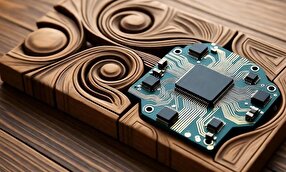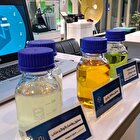Top News of Last Week with ANA

Azad News Agency (ANA) published a number of scientific and technological news during the past week whose top ones are as follows:
Iranian Knowledge-Based Firm Makes Simulator for Dentistry Students
Iranian researchers at a knowledge-based company succeeded in designing and building a dental surgery medical training simulator.
This device is designed specifically for dental surgeries. In addition to providing the dentistry students with the ability to physically perform surgery, the device includes a series of training courses dedicated to each stage of surgery. The training courses are displayed in three dimensions (3D) and simulate the clinical space for the student, so that they can realistically experience all stages of surgery.
In this device, all the necessary tools for dental surgery, including turbines, mirrors, and pedals, are simulated. The dentistry students complete various courses in this device and are then tested by a scoring system at the end.
This scoring system helps the students understand the extent of their errors. Before they enters the actual surgical phase on a patient, they can practice their skills on this device to prevent potential errors.
Iranian Knowledge-Based Firm Produces Lab Equipment for Schools
An Iranian knowledge-based company has succeeded in making high-quality laboratory equipment for the country’s schools, and exported them to the neighboring states.
“Our activity is focused on the production of laboratory equipment related to physics grade 1 and 2. I have about 30 years of experience in this field and have so far cooperated with 70 to 80 universities across the country. We have also received quality approvals from some universities and have also equipped the laboratories of two universities in the Iraqi Kurdistan region,” Ali Mohammad Khaleqi, the director of Milad laboratory equipment production workshop, told ANA.
Noting that their products can compete in quality with foreign models, he said, “As a confirmation for this claim, the device we presented to Bu Ali Sina University 30 years ago is still working. We are the first in the field of quality.” “50 percent of the inclined plane, free fall and Atod machine devices that we presented to Bu Ali University 30 years ago are still in use. These devices are designed for the university level, although they are also suitable for high schools,” Khaleqi said.
Iranian Scientists Produce Radiopharmaceutical Used for 90 Percent of Cancer Patients
An Iranian knowledge-based company has succeeded in production of the active ingredient of technetium diagnostic radiopharmaceutical which can be used for 90% of cancer patients.
The radiopharmaceutical produced by the company, as one of the most specialized radiopharmaceuticals for lymph node diagnosis, has settled this problem. By injecting this radiopharmaceutical and performing a scan, surgeons can identify the exact location and extent of cancer-infected lymph nodes. This technology increases the accuracy of diagnosis and prevents unnecessary surgeries and its complications.
The production of this advanced radiopharmaceutical was monopolized by the US since 2013 but with the efforts of the Iranian specialists, the technical know-how for its production became completely indigenous. After successfully passing the preclinical stages, this medicine has entered the clinical phase.
This product is a complex polymer macromolecule that, in addition to being able to carry the technetium diagnostic radioisotope, can bind to receptors on the surface of cancer cells. This feature allows this drug to identify cancer cells with high accuracy.
Iranian Firm Makes Cost-Effective Hydraulic Knee Joint
A knowledge-based company in Iran has succeeded in producing the IR60 hydraulic knee joint, which facilitates the mobility and daily activities of people with knee amputations at an affordable price.
“This product enables the person to control the speed of movement in the two phases of flexion and extension separately. Also, the EBS mechanism in this joint, while entering the standing phase and when the heel hits the ground until entering the foot flexion phase, is responsible for controlling the secondary flexion and stability of the joint,” said Reza Iranpour, the managing director of the knowledge-based company.
Noting that the technology leads to a reduction in the energy consumed by the person while walking and a reduction in the impact felt in the remaining limb, pelvis and spine, he said, “When EBS is inactive, the intersection of the lines of the 4-bar mechanism is located close to the instantaneous axis of rotation of the joint, which allows the person to bend the joint at will. However, when the EBS system is activated, this intersection is moved away from the instantaneous axis of rotation, and the locking mechanism prevents the joint from bending due to the passage of the weight line. This intelligent design provides the user with security and stability of movement.”
“Meantime, the resistance of the EBS system is directly related to the speed of movement, meaning that at higher speeds, the EBS function does not prevent the joint from moving smoothly,” Iranpour said.
Iranian Scientists at Royan Institute Make 5 Diagnostic, Therapeutic Products
Iranian researchers at one of the technological companies affiliated to Royan Research Institute succeeded in making five diagnostic and therapeutic products which can help treat cancers.
“Our company produces oligonucleotide products (miRNA, siRNA and antisense, probes and biomarkers) that are used to treat most diseases and cancers. Oligonucleotide products are designed against these genes and protect cells from becoming cancerous,” Sa’eed Mohebbi, the company’s R&D manager, told ANA.
He explained that sometimes heteroduplexing occurs, meaning the designed template is DNA, but it is used against RNA, and it destroys the RNA, which is the product of the pathogenic gene and progresses towards becoming cancerous, and prevents the cells from becoming cancerous.
“Some other molecules are microRNAs, or miRNAs for short, which regulate gene expression. Although these molecules inhibit gene expression, in some cases they work in favor of cancer cells, so we have designed a product called antagomirs. This product inhibits miRNA molecules and prevents the development of cancer cells,” Mohebbi said.
“siRNA is also designed against a specific gene and inhibits gene expression. Diagnostic products in this series also include a variety of probes and different forms of biomarkers. Markers and biomarkers enter the bloodstream and body fluids. Through these markers, a person can be identified as having cancer,” he added.
Iranian Researchers Develop Biocomputational Method to Show Effectiveness of Drugs
Iranian scientists at a technological center at the Royan Research Institute succeeded in presenting a biocomputational method to show which drugs are more effective during the outbreak of epidemics like the coronavirus.
“One of the important applications of biocomputational laboratories is that it reduces the use of animal models and, while respecting medical ethics and reducing costs, saves time,” Soudeh Mahdian, a PhD in biochemistry and postdoctoral researcher at the Royan Research Institute and a member of the company, told ANA.
“In this method, the effectiveness of drugs is evaluated using computational methods before the animal model is performed. During the outbreak of the coronavirus, most drugs were given to patients randomly. Then their effectiveness was evaluated, but with the biocomputational method, we can assess which drugs are more effective,” she added.
“Now, by implementing this method, we have achieved good results and have been able to have scientific cooperation with Baqiyatollah Hospital (in Tehran). We have also defined joint projects with several research institutes in this field,” Mahdian said.
Reducing Environmental Pollution with Iran-Made Oxidative Desulfurization Catalysts
A knowledge-based company in Iran has succeeded in indigenizing oxidative desulfurization catalysts which is an effective method for removing sulfur compounds in different oil fractions and significantly contributes to reduction of environmental pollutions.
“Oxidative desulfurization is an effective method for removing sulfur compounds present in various oil fractions. This method can also be used to regenerate sodium hydroxide (used caustic stream) used in MERAX units that use caustic to decrease the concentration of sulfur and mercaptans present in hydrocarbon fractions,” said Hassan Navayee Alvar, the managing director of the knowledge-based company.
He explained that removing mercaptan compounds from various oil fractions and crude oil is possible by using the DMD process, which involves several steps.
“The technical know-how of producing this catalyst has been developed for the first time in Iran as a heterogeneous catalyst. The sample of this catalyst was produced in our plant and its performance was assessed through numerous tests on a laboratory scale and a continuous laboratory pilot and with feedstock from various refineries,” Navayee Alvar said.
“This catalyst, which has undergone its laboratory and pilot stages using feedstock from Shiraz and Tehran refineries, enjoys the potential to be commercialized in refineries, mini refineries and related centers, given the volume of fuel oil stored in Iran and the problem of providing low-sulfur fuel suitable for related uses, including shipping fuel,” he underlined.
Official Predicts 15-Billion-Dollar Market for Iran’s Medicinal Plants Next Year
The market capacity of Iran's herbal and traditional medicine for the next Persian calendar year (to start on March 21) is estimated at nearly 13-15 billion dollars, an official said.
“The value of this sector in the production and harvesting sector is $1.5 to $2 billion, in the import sector of medicinal plants $0.15 billion, in the export sector of medicinal plants $0.5 billion, and in the import sector of essential oils and extracts $0.3 billion,” said Seyed Seif Sahandi, the deputy head of the Technology Development Headquarters for Medicinal Plants and Traditional Medicine of Iran.
“The market capacity of medicinal plants and traditional medicine is estimated at approximately $13 to $15 billion,” he said, adding that the value chain of medicinal plants industries is $10 to $11 billion, and the value chain of traditional medicine is $2.7 to $4 billion.
“A year ago, the area under cultivation of medicinal plants was nearly 224,000 hectares, of which 50% is related to saffron cultivation. Cumin with 15%, rosehip with 10%, and fixweed with 5% are in the next ranks of the area under cultivation of medicinal plants, respectively,” Sahandi noted.
Iranian Scientists Produce Anti-Cancer Drug from ‘Chinese Lantern’ Plant
A member of the faculty of the Aerospace Research Institute, with the support of the National Science Foundation of Iran, succeeded in acquiring the technical know-how of in vitro propagation and cell suspension cultivation to produce the anti-cancer compound physalin from the Chinese Lantern (Alkekengi) plant.
“The Chinese Lantern is an annual or perennial plant that grows in temperate regions of the world. This plant has anti-cancer and anti-diabetic therapeutic properties and has received much attention today,” said Halimeh Hassanpour, a PhD in Plant Biology-Physiology and an associate professor of the Aerospace Physiology Department of the Aerospace Research Institute.
“Given the value of the physalin compound, we sought to regenerate and propagate the plant through tissue and cell culture to protect and sustainably utilize their genetic resources,” she added.
“In this research, the seeds were placed in a culture medium after sterilization, and the resulting seedlings were used for callus induction and cell suspension cultivation. The cells were then exposed to a specific magnetic field intensity and their medicinal metabolite content was stimulated,” Hassanpour said.
She noted that the results of this research, in addition to preserving the genetic resources of Iran’s indigenous and valuable medicinal species, have paved the way for the semi-industrial production of medicinal metabolites in vitro and the development of cell culture technology.
University of Tehran Scientists Design Material Interaction Detection Device
Iranian researchers at the Intelligent Systems Department of Interdisciplinary Faculties of Sciences and Technologies of the University of Tehran designed a new surface plasmon resonance imaging system.
“The technology used in this device is based on surface plasmon resonance (SPR). The SPR optical sensor system is an influential tool in biosensor technology that has an unlabeled nature, remarkable sensitivity, and the ability to provide real-time detection. SPR sensors provide accurate measurements of molecular interactions, including biological and chemical analytes, by considering changes in refractive indices,” said Mohammad Mohammadi Massoudi, a faculty member of the Intelligent Systems Department of Interdisciplinary Faculties of Sciences and Technologies of the University of Tehran.
“This device has significant advantages, including cost-effectiveness and the ability to perform simultaneous comparative studies. SPRI-based biosensors have attracted the attention of many researchers in the biochemical field due to their unique features, including multiple detection, simple and stable configuration, and real-time monitoring,” he added.
“In similar commercially produced samples, initial settings are required by inserting the sensor chip. However, in this device with the technique used, initial settings of the optical system are no longer required. Also, the cost of manufacturing the device is much lower than foreign samples,” Mohammadi Massoudi underlined.
Iranian Firm Develops Technological System to Intelligize Research, Educational Processes
An Iranian company has developed an innovative technological system of digital economy that by focusing on artificial intelligence technologies makes research and educational processes smarter.
“The Shivangar system is an innovative product in the field of digital economy that, by focusing on artificial intelligence technologies, makes research and educational processes smarter,” Mohammad Ali Saremi Nayeeni, the founder of Shivangar software and system stationed at the incubator center of the Islamic Azad University’s Yazd branch, told ANA on the sidelines of Asr-e Omid event in the Central city of Isfahan.
“By creating an integrated platform, this software helps researchers and students facilitate research processes and provides the opportunity to benefit from new digital achievements in the scientific field,” he added.
“Along with artificial intelligence, a serious approach to collecting and analyzing big data is on the agenda, the main goal of which is to create effective communication with society and industry, identify talents, and create job opportunities,” Nayeeni said.
“This strategy, focusing on innovation and intelligence, seeks to prevent undesirable and unethical uses of technology by taking advantage of its opportunities,” he noted.
Iranian Firm Finds Way for Creating IoT-Based Businesses with LoRaWAN Technology
An Iranian technological company has used LoraWAN technology in the field of digital economy which can reduce costs, increase productivity, create new businesses based on the Internet of Things, improve the quality of life, and provide better services to citizens.
“So far, we have worked on LoRaWAN technology and we have implemented different projects from smart cities to LoRaWAN-related fields,” Rassoul Sadeqi, the managing-director of the company, told ANA on the sidelines of Asr-e Omid event in Isfahan city.
“We use LoRaWAN technology in places where we need very brief information from a data, and the energy level required to send this data is also very low in a way that we can install the battery in a remote area and use it to measure parameters and replace the battery after 10 years; therefore, its energy consumption is very low,” he added.
Sadeqi explained that LoRaWAN technology is used in smart city management, smart lighting management, smart parking lot management, smart waste collection, agricultural monitoring (soil moisture, temperature and ambient light), livestock tracking, industrial equipment monitoring, management of various facilities, including warehouses and tracking medical equipment or specific diseases in the health sector, etc.
“In the field of digital economy, LoRaWAN technology can reduce costs, increase productivity, create new IoT-based businesses, improve the quality of life and provide better services to citizens,” he underlined.
4155/v





















